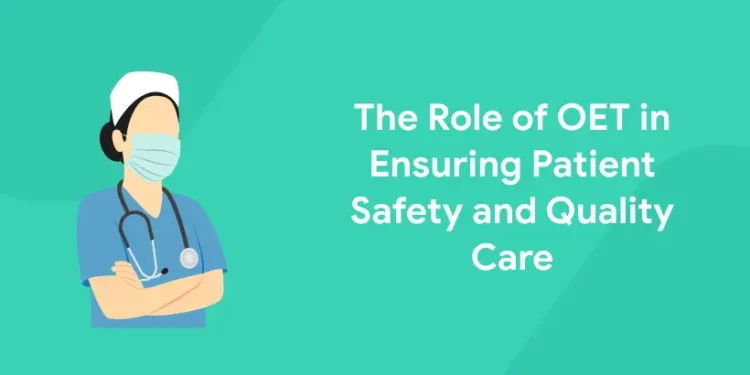Table of Contents
The only international English language test in the world designed particularly for healthcare workers is OET. It evaluates the language skills of healthcare professionals who wish to enroll, work, or learn in an English-speaking setting. With a focus on the forms of communication necessary in healthcare settings, the exam offers a valid and accurate assessment of all four language skills—listening, reading, writing, and speaking. Discover the role of OET in ensuring patient safety and quality care.
How is OET Different to Other English Language Tests?
Patient safety and quality of care
The language requirements of the healthcare industry were the focus of OET’s creation. The test materials were created in collaboration with subject matter experts to accurately reflect the English language proficiency needed in healthcare settings to provide high-quality patient care. Candidates learn precisely the language they will need at work every day while preparing for the OET.
Valid and Reliable
OET is a reliable and valid way to evaluate a healthcare professional’s English language proficiency. The test is owned by Cambridge Boxhill Language Assessment, a partnership between the Box Hill Institute and Cambridge Assessment English, the company behind the IELTS.
OET is supported by ongoing research conducted by Cambridge Assessment English and the University of Melbourne, and it is updated as needed at regular intervals to keep the test relevant to the healthcare sector. The Writing sub-exam assessment standards were modified in 2019, whereas the most recent significant test update occurred in September 2018.
All tests are double-marked by skilled examiners, and the validity and reliability of the results are confirmed through a careful statistical analysis.
crack oet exam with entri’s online coaching !
Highly Secure
Given the test’s high stakes, security is essential for both the test’s administration and the mechanism we use to verify the results. World-class candidate identity checking technology is used at all OET test locations, and malpractice checks are conducted at various stages of the testing process.
The OET online results verification service enables OET recognized organizations to quickly and accurately verify the validity of OET results. The service gives users access to a safe, encrypted database where they may check the performance of candidates. Additionally, a candidate must grant the verifier authorization in the system before the verifier can view their results, safeguarding the privacy of the candidate.
Unlock your professional potential with our specialized OET course! Book for Free Demo Class!
Recognised by leading healthcare institutions
OET is acknowledged by medical authorities and academic institutions in the United States, Australia, New Zealand, the United Kingdom, Ireland, Singapore, Dubai, Namibia, and the Ukraine, including:
- The General Medical Council (UK)
- The Nursing and Midwifery Council (UK)
- Australian Health Practitioner Regulation Agency (AHPRA)
- The Medical Council (Ireland)
- The Nursing and Midwifery Board of Ireland
- Educational Commission for Foreign Medical Graduates | Foundation for Advancement of International Medical Education and Research (ECFMG®|FAIMER®)
- Florida Board of Nursing
- Oregon State Board of Nursing
OET is also approved for immigration and visa reasons in Australia and New Zealand.
| OET COACHING OFFERED | ||
| OET Coaching Classes | OET Coaching in Calicut | OET Coaching in Kochi |
| OET Coaching in Kottayam | OET Coaching in Thrissur | OET Coaching in Trivandrum |
Effects of Communicative Skills on Healthcare
1: What is the primary purpose of a patient’s discharge summary?
As we’ve seen, the communication abilities of healthcare professionals are under unprecedented demand due to current worldwide trends. What effects do the professional’s communication style or quality have on the results of healthcare?
Patient satisfaction and quality of care
It practically goes without saying that a lack of effective communication among medical staff has an impact on patient satisfaction and the standard of service. Patients may be experiencing stress or anxiety at the time of the interaction; they could also be experiencing drug side effects, have a persistent impairment, or feel frightened by the medical staff. Additionally, they could feel intimidated and perplexed by new concepts and procedures, and awkward about seeking explanation. Therefore, healthcare practitioners must make sure that their communication is precise, truthful, and situationally appropriate. In spite of this, a recent investigation into 125 patient complaints at a Singapore hospital found that during patient-doctor interactions, doctors were criticised for speaking brusquely and tactlessly and providing insufficient information (Kee, Khoo, Lim, & Koh, 2018). Furthermore, one-third of all healthcare complaints in the UK in 2014–2015 were found to be related to poor communication, including the quality and accuracy of information (Parliamentary and Health Service Ombudsman, 2015).
Nonverbal cues from the healthcare provider, such as eye contact, proximity, and facial expressions, have been found to be just as crucial as verbal cues in assessing the quality of care and patient satisfaction.
Patient engagement and compliance
Patient involvement and compliance are strongly positively correlated with healthcare workers’ communication abilities. Patients are better able to adhere to medical advice, self-manage chronic conditions, and adopt the desired preventive health behaviours when they believe their doctor is explaining things clearly, providing adequate information, and demonstrating appropriate empathy and understanding (Institute for Healthcare Communication, 2019).
On the other side, a lack of effective communication between patients and medical staff can result in patients skipping appointments, forgetting to take their medications, and eventually ceasing to receive care (Vermeir et al., 2015). This can result in extremely poor health outcomes, including mortality, in the modern world of escalating chronic diseases that need long-term management.
Get your Desired OET Scores in Weeks! Get Free Demo Class Here!
Patient Safety
Patient damage or even death can result from inadequate provider-patient communication (Joint Commission International, 2018). The Risk Management Foundation of the Harvard Medical Institutions found that in the US, communication errors contributed to 30% of all malpractice claims, which resulted in 1,744 fatalities and $1.7 billion in malpractice expenditures over a five-year period (CRICO Strategies, 2016).
Similarly, a poll of inpatients at three NHS Trusts in the UK found that patients’ top concerns regarding hospital care was communication issues. 2018; O’Hara et al. Although frightening, these rates are not surprising given that hospital patients are likely to interact with two to three distinct staff shifts each day, in addition to a variety of other healthcare experts who are performing rounds, conducting tests, and offering treatment. Each of their interactions with patients and their interactions with one another, both vocally and in writing, include communication. Even the smallest miscommunication—such as mishearing or misreading 1 ml as opposed to 0.1 ml—can have catastrophic consequences for patient outcomes.
Crack OET & Boost Your Healthcare Career!
OET Coaching by Entri App: Get expert guidance, practice with real exam scenarios, and achieve your target score to advance your healthcare career.
Join Now!ace your oet exams with desired band scores !
Limited language proficiency
Similar findings were found in a poll of patients at three NHS Trusts in the UK, which showed that individuals’ top worries about hospital care was communication issues. in 2018 (O’Hara et al.). These rates, though frightening, are not shocking considering that hospital patients are likely to interact with two to three distinct shifts of staff each day, in addition to a variety of other healthcare experts who are doing rounds, doing tests, and giving care. Each time they interact with patients and when they converse vocally or in writing with one another, they are communicating. Even the smallest miscommunication—such as hearing or reading 1 millilitre instead of 0.1 milliliter—can have a devastating impact on patient outcomes.
The US, UK, Canada, Australia, New Zealand, and Ireland are examples of English-speaking nations that have responded by requiring international healthcare workers to pass an English language test. However, general English language tests do not evaluate the specific communication skills necessary for the healthcare industry, including understanding of industry-specific lingo, attention to interpersonal dynamics, the capacity to demonstrate empathy and inspire confidence, situational awareness, and cultural competency.
| Related Links | |
| OET Exam 2023 | OET Speaking – Complete Guide |
| OET Speaking Preparation Tips | OET Reading – Complete Guide |
| OET vs IELTS | OET Mock Test |










